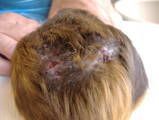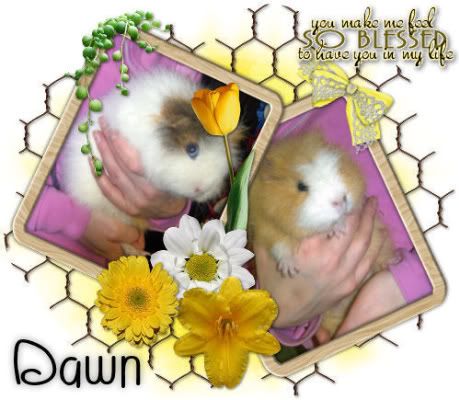Post by Dawn - Admin on Aug 13, 2007 23:28:05 GMT
Small But Deadly
Mange Mites (also known as Burrowing Mites) are one of the most common form of skin problem encountered by piggies. Mange Mites are microscopic burrowing mites that live under the skin. They can cause a lot of pain along with intense scratching and biting. Hair around the infested area is often thinning, and may be broken off half way down the hair shaft. Guineas bite and scratch themselves causing open sores that can become infected, so prompt treatment is required. Weightloss may also occur as the guinea becomes so uncomfortable that he is unable to eat, drink or sleep properly. In serious cases the guinea may also start fitting. Your guinea may even bite you if you pick it up because it is so uncomfortable. Guinea nails should always be kept short to minimise the damage done by scratching.
Mange Mites can kill guineas if not treated promptly, so if you suspect that your guinea has Mange Mites,
please take it to your Vet for treatment as soon as possible.
Guineas can carry Mange Mites around without any problems but they can start multiplying and showing symptoms when the guinea is stressed or has a depressed immune system. Often you will find that the following types of guineas are affected:
pregnant sows
sows who have recently given birth
babies
oldies
guineas who have been ill and don't have a fully functioning immune system
guineas who have been stressed (a change of home for example)
poor environmental conditions - ie using shavings for bedding and not being cleaned out and disinfected often enough
Treatment is with Ivomectin, usually by injection. Two or three doses are required and these doses are usually given 10 days apart. Ivomectin does not kill eggs that the Mites have laid, so the first injection will kill the live Mites and the second will kill the Mites that have hatched from the eggs laid by the first lot of Mites. If the infestation has been particularly bad, a third treatment may be required. Ivomectin works very quickly, so within a few hours of the first treatment you should see your guinea scratching less and feeling a little more comfortable. Wounds will then start to heal, scabs will form / drop off, and new hair will soon start growing. Plain Aloe Vera Gel is very cooling and soothing when applied to sores like this.
Guineas often get Fungal skin problems at the same time as Parasitic ones. CocoNeem Melt combined with Manuka & Neem Shampoo works very well where there is a Fungal skin problem, but Mange Mites MUST be treated with Ivomec.
This pigture from Thistle Cavies Rescue shows a boar badly affected with Mites. He was treated with Ivomec and within 4 week his scabs had healed and all his hair had grown back:)

As ever, prevention is better than cure so that is why we recommend regular 4 - 6 week shampooing with Gorgeous Guineas shampoos, not using shavings for bedding and cleaning / disinfecting cages at least twice a week. Check out our Top Tips page.
This article is for information only and is no substitute for proper Veterinary care and treatment.
© Gorgeous Guineas 2007
Mange Mites (also known as Burrowing Mites) are one of the most common form of skin problem encountered by piggies. Mange Mites are microscopic burrowing mites that live under the skin. They can cause a lot of pain along with intense scratching and biting. Hair around the infested area is often thinning, and may be broken off half way down the hair shaft. Guineas bite and scratch themselves causing open sores that can become infected, so prompt treatment is required. Weightloss may also occur as the guinea becomes so uncomfortable that he is unable to eat, drink or sleep properly. In serious cases the guinea may also start fitting. Your guinea may even bite you if you pick it up because it is so uncomfortable. Guinea nails should always be kept short to minimise the damage done by scratching.
Mange Mites can kill guineas if not treated promptly, so if you suspect that your guinea has Mange Mites,
please take it to your Vet for treatment as soon as possible.
Guineas can carry Mange Mites around without any problems but they can start multiplying and showing symptoms when the guinea is stressed or has a depressed immune system. Often you will find that the following types of guineas are affected:
pregnant sows
sows who have recently given birth
babies
oldies
guineas who have been ill and don't have a fully functioning immune system
guineas who have been stressed (a change of home for example)
poor environmental conditions - ie using shavings for bedding and not being cleaned out and disinfected often enough
Treatment is with Ivomectin, usually by injection. Two or three doses are required and these doses are usually given 10 days apart. Ivomectin does not kill eggs that the Mites have laid, so the first injection will kill the live Mites and the second will kill the Mites that have hatched from the eggs laid by the first lot of Mites. If the infestation has been particularly bad, a third treatment may be required. Ivomectin works very quickly, so within a few hours of the first treatment you should see your guinea scratching less and feeling a little more comfortable. Wounds will then start to heal, scabs will form / drop off, and new hair will soon start growing. Plain Aloe Vera Gel is very cooling and soothing when applied to sores like this.
Guineas often get Fungal skin problems at the same time as Parasitic ones. CocoNeem Melt combined with Manuka & Neem Shampoo works very well where there is a Fungal skin problem, but Mange Mites MUST be treated with Ivomec.
This pigture from Thistle Cavies Rescue shows a boar badly affected with Mites. He was treated with Ivomec and within 4 week his scabs had healed and all his hair had grown back:)

As ever, prevention is better than cure so that is why we recommend regular 4 - 6 week shampooing with Gorgeous Guineas shampoos, not using shavings for bedding and cleaning / disinfecting cages at least twice a week. Check out our Top Tips page.
This article is for information only and is no substitute for proper Veterinary care and treatment.
© Gorgeous Guineas 2007





